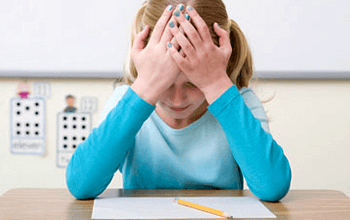
I don’t want to go,” the child says.
“Well, why not?” his mother asks.
“Because I don’t know anyone, and I’m going to be left out. There’s big kids there, and they’ll be mean. I might get sick or throw-up. I’m not going.”
This may be a typical conversation between a child with anxiety and his mother
The child is afraid to go somewhere, and his mother is trying to help. If these types of situations happen often, or his anxiety makes it hard for him to live the life he wants, his parents may seek therapy for this child to help him get past his fears.
Anxiety, stress, and worry are common concerns for children and adolescents. In these circumstances, many therapists use cognitive behavioral therapy, a type of intervention strongly supported in research for children with anxiety. This type of therapy teaches children how their thoughts can impact what they feel and do.
An example of how thoughts can influence behavior came up in my household this morning
I asked my 7-year-old to practice his piano. If he told himself, “I can do this,” or “I like the song I’m playing, even if I don’t have all the kinks worked out yet,” he may feel upbeat, and approach the task easily. If he told himself, “This song is too hard and it will take forever,” he may feel angry, sad, or frustrated, and possibly cry or pout when asked to practice.
With cognitive behavioral therapy, therapists typically help children notice and label their thoughts and feelings
Next, they teach them to change negative thinking patterns, so the children can feel better and can manage their behaviors more easily. Often, children and parents like this approach because it is straightforward, hands-on, and effective. Parents are often involved through reward programs and homework exercises.
In a new study, one group of researchers (Hogendoorn et al, 2014) attempted to find what parts of cognitive behavioral therapy were most helpful for anxious youth
Their findings were somewhat surprising. The children in their study benefited the most from the therapist coaching positive thinking skills (“I can do it,” “It’s not so bad,” etc.), rather than the therapist trying to decrease negative thinking patterns (“I don’t want to go.” “They’ll be mean.”)
What are the implications of this study for parents, teachers, caregivers, and therapists?
This study suggests that, for anxious children, it is important to focus on the positive, rather than the negative
It is important to praise our children when they identify or voice coping thoughts. Further study is needed, but it is possible that by “correcting” negative thoughts, children with anxiety feel criticized, less perfect, or even more anxious.
It is important to teach our children positive coping thoughts
Many children, particular children with anxiety or worries, tend to have fewer optimistic, or positive thoughts. We can teach our children these thoughts directly by repeating them often. For example, introduce some of the following into conversations at home with your child:
“I am brave.”
“I am smart.”
“I am important.”
“It doesn’t have to be perfect to be great.”
“I have done this before, and it worked out.”
“I am ok.”
“In this moment, I am good.”
“I just have to take it one small step at a time.”
“It is ok.”
“It will be ok.”
Write down coping thoughts and hang them up around your house, put them in your child’s backpack or lunch, or squeeze them into their piano books
I have a plaque on our fireplace that reads, “Life doesn’t have to be perfect to be wonderful.” It is front and center for us all to remember.
Model these thoughts to your children
When you encounter something stressful in your day (and we all do), repeat these phrases out loud FOR YOURSELF. Your child will hear you, understand it’s a good thing to use coping thoughts, and learn when to use them. It’s a beautiful thing. It also sends your child the message that we ALL need to use coping thoughts from time to time. It is healthy for everyone.
References
- Hogendoorn, S.M., Prins, P.J., Boer, F., Vervoot, L., Wolters, L.H., Moorlag, H., Nauta, M.H., Garst, H., Hartman, C.A., and Haan, E. (2014).
- Mediators of Cognitive Behavioral Therapy for Anxiety-Disordered Children and Adolescents: Cognition, Perceived Control, and Coping. Journal of Clinical Child and Adolescent Psychology, 43 (3), 486-500.
![]()
